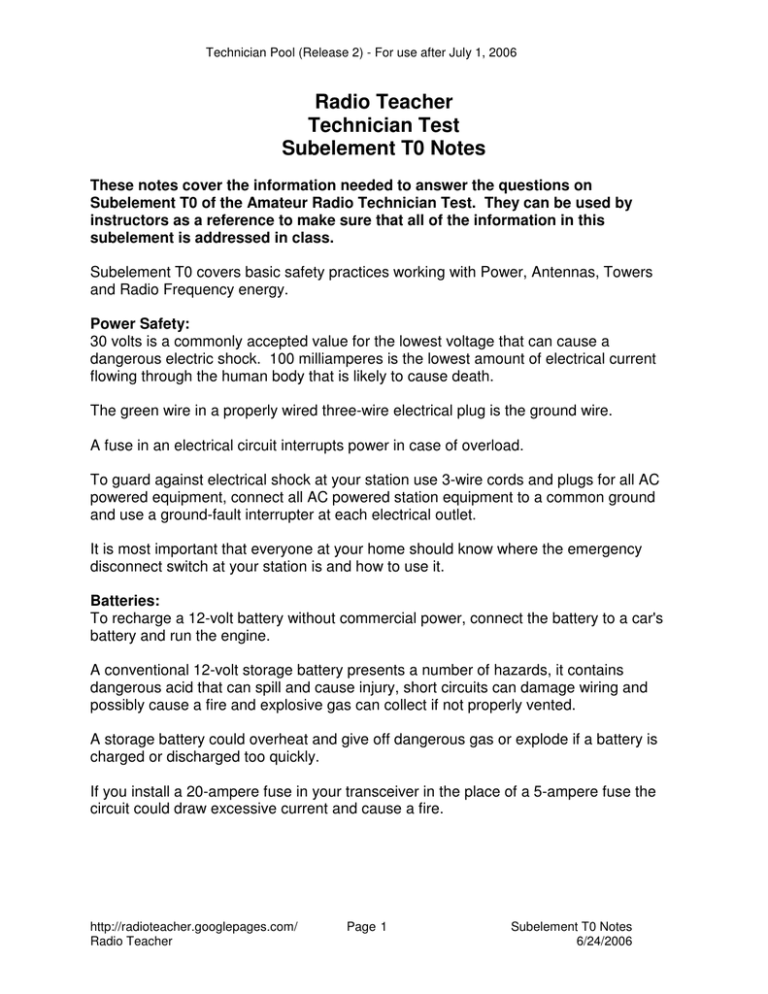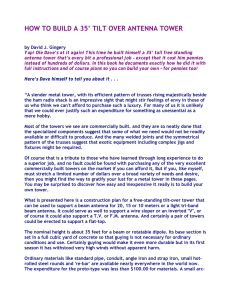Techpool SE T0 Notes
advertisement

Technician Pool (Release 2) - For use after July 1, 2006 Radio Teacher Technician Test Subelement T0 Notes These notes cover the information needed to answer the questions on Subelement T0 of the Amateur Radio Technician Test. They can be used by instructors as a reference to make sure that all of the information in this subelement is addressed in class. Subelement T0 covers basic safety practices working with Power, Antennas, Towers and Radio Frequency energy. Power Safety: 30 volts is a commonly accepted value for the lowest voltage that can cause a dangerous electric shock. 100 milliamperes is the lowest amount of electrical current flowing through the human body that is likely to cause death. The green wire in a properly wired three-wire electrical plug is the ground wire. A fuse in an electrical circuit interrupts power in case of overload. To guard against electrical shock at your station use 3-wire cords and plugs for all AC powered equipment, connect all AC powered station equipment to a common ground and use a ground-fault interrupter at each electrical outlet. It is most important that everyone at your home should know where the emergency disconnect switch at your station is and how to use it. Batteries: To recharge a 12-volt battery without commercial power, connect the battery to a car's battery and run the engine. A conventional 12-volt storage battery presents a number of hazards, it contains dangerous acid that can spill and cause injury, short circuits can damage wiring and possibly cause a fire and explosive gas can collect if not properly vented. A storage battery could overheat and give off dangerous gas or explode if a battery is charged or discharged too quickly. If you install a 20-ampere fuse in your transceiver in the place of a 5-ampere fuse the circuit could draw excessive current and cause a fire. http://radioteacher.googlepages.com/ Radio Teacher Page 1 Subelement T0 Notes 6/24/2006 Technician Pool (Release 2) - For use after July 1, 2006 Power Supply: You might receive an electric shock from stored charge in large capacitors in a power supply when it is turned off and disconnected. These capacitors can store energy for some time after the unit is turned off. Tower Safety: To protect your head and eyes in case something accidentally falls from the tower you should wear a hard hat and safety glasses if you are on the ground helping someone work on an antenna tower. The person on the tower should also wear a hard hat to protect them from guy wires and antenna mounts when climbing. Inspect your safety belt (D Rings, buckles and lanyard) for damage or rot and replace any or all of it if needed. A good precaution to observe is to put on your hard hat, safety belt and safety glasses before climbing an antenna tower. After putting on your safety belt, test the belt and lanyards at the base of the tower before climbing. Before you climb a tower arrange for a helper or observer, inspect the tower for damage or loose hardware and make sure there are no electrical storms nearby. Before putting up an antenna it is an important consideration to make sure people cannot accidentally come into contact with any part of the antenna. Before erecting an antenna near an airport know the maximum allowed height with regard to nearby airports. When putting up an antenna tower look for and stay clear of any overhead electrical wires. Before putting up an antenna in a new area make a site survey of any hazards that exist. When erecting the antenna one person should be designated as a Safety Officer. The Safety Officer stands a distance from the antenna and observes the installation while looking for hazards. Guy wires for an antenna tower should always be installed in accordance with the tower manufacturer's instructions. A safe distance when installing an antenna is that if the antenna falls unexpectedly, no part of it can come closer than 10 feet from a power line. A crank-up tower should never be climbed unless it is in the fully lowered position Stainless steel hardware is much less likely to corrode. That is why it is common on many antennas instead of other metals. Separate 8 foot long ground rods for each tower leg, bonded to the tower and each other is considered to be an adequate ground. http://radioteacher.googlepages.com/ Radio Teacher Page 2 Subelement T0 Notes 6/24/2006 Technician Pool (Release 2) - For use after July 1, 2006 Lightning: Take the following precautions when a lightning storm is expected: Disconnect the antenna cables from your station and move them away from your radio equipment, unplug all power cords from AC outlets and stop using your radio equipment finally move to another room until the storm passes. Fire prevention is the most important reason to have a lightning protection system for your amateur radio station. RF Effects and Safety: VHF and UHF radio signals are classified as non-ionizing radiation. Radio waves can cause injury to the human body only if the combination of signal strength and frequency cause excessive power to be absorbed. The maximum power level before an RF exposure evaluation is required of an amateur radio station at frequencies above 30 MHz is 50 watts PEP at the antenna. The factors that affect the RF exposure of people near an amateur transmitter are frequency and power level of the RF field, distance from the antenna to the person and the radiation pattern of the antenna. The human body absorbs more RF energy at some frequencies than others this is why the frequency of an RF source be considered when evaluating RF radiation exposure. You can determine that your station complies with FCC RF exposure regulations by calculation based on FCC OET Bulletin 65, by calculation based on computer modeling or by measurement of field strength using calibrated equipment. If a person accidentally touched your antenna while you were transmitting they might receive a painful RF burn injury. Amateur operators can take the following actions to prevent exposure to RF radiation in excess of FCC supplied limits: Altering the antenna patterns, relocating the antenna or changing station parameters such as frequency or power. You should re-evaluate the station whenever an item of equipment is changed to make sure your station stays in compliance with RF safety regulations Milliwatts per square centimeter are the units of measurement used to measure RF radiation exposure. Duty cycle is one of the factors used to determine safe RF radiation exposure levels. It takes into account the amount of time the transmitter is operating http://radioteacher.googlepages.com/ Radio Teacher Page 3 Subelement T0 Notes 6/24/2006


